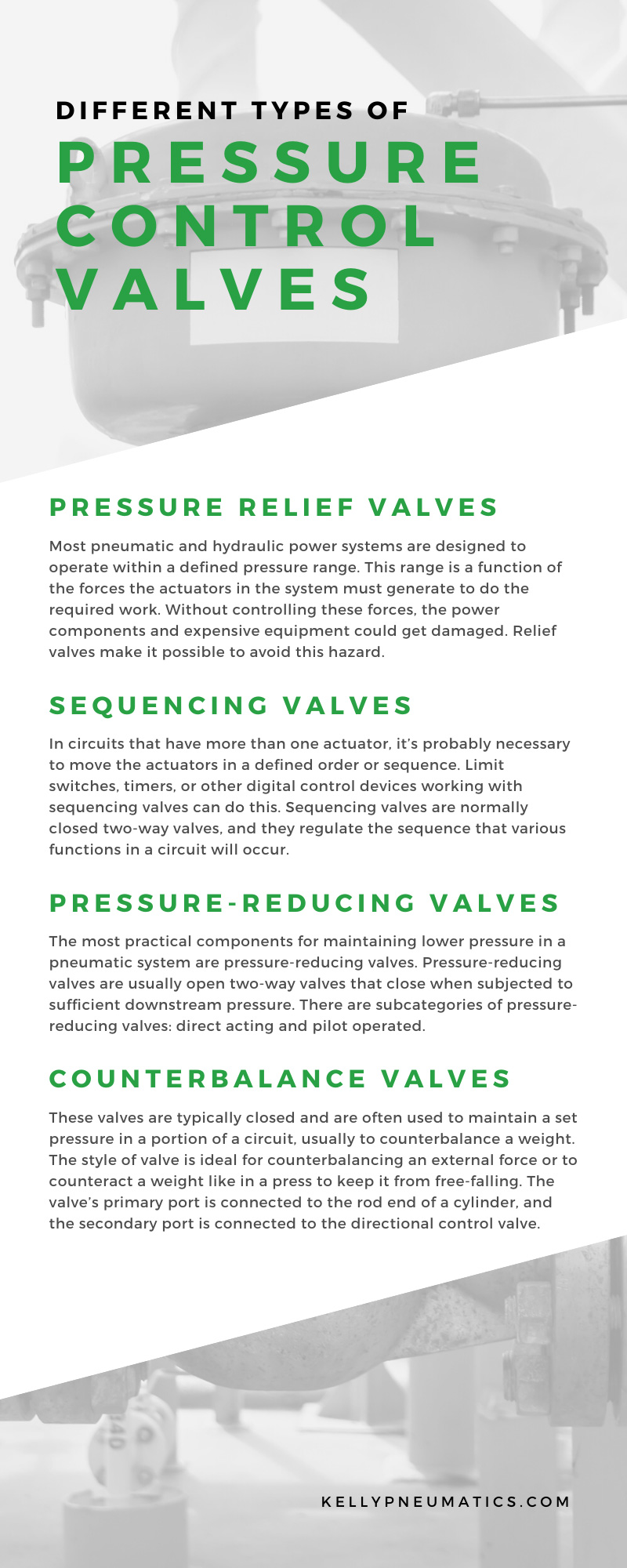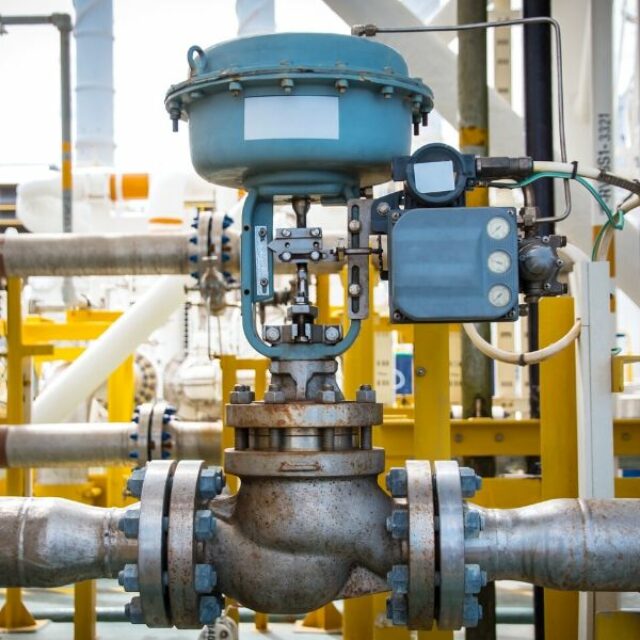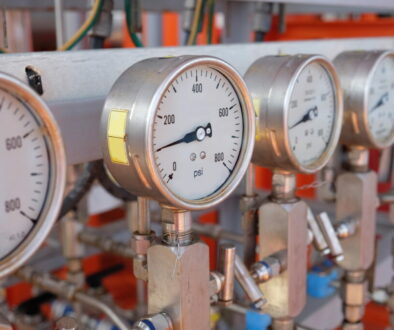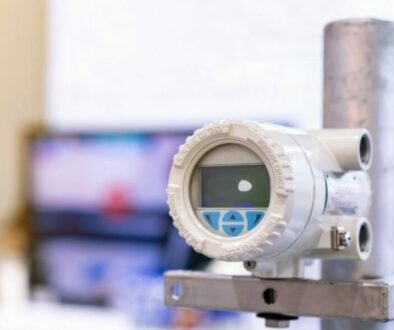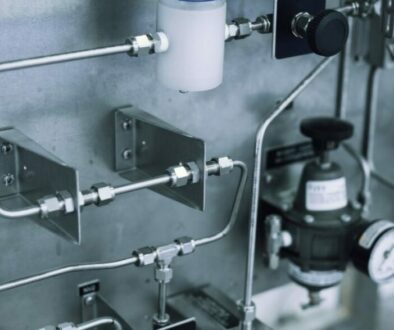Different Types of Pressure Control Valves
Pressure-control valves are found in practically every pneumatic and hydraulic system. They help in a variety of functions, from keeping system pressures below a desired limit to maintaining a set pressure level in part of a circuit. Different types of pressure control valves include relief, reducing, sequence, counterbalance, safety, and unloading. All of them are typically closed valves, except for reducing valves, which are usually open. For most of these valves, a restriction is necessary to produce the required pressure control. One exception is the externally piloted unloading valve, which depends on an external signal for its actuation, which normally comes from a digital pressure regulator. In certain applications, like ventilators and anesthesia machines, the flow must be consistent at all times. Variations in the flow of gases can lead to serious injury or death. That’s why control valves are so important.
Pressure Relief Valves
Most pneumatic and hydraulic power systems are designed to operate within a defined pressure range. This range is a function of the forces the actuators in the system must generate to do the required work. Without controlling these forces, the power components and expensive equipment could get damaged. Relief valves make it possible to avoid this hazard. They are the safeguards that limit maximum pressure in a system by diverting excess gases when pressure gets too high. The pressure at which a relief valve first opens to allow fluid to flow through is known as cracking pressure. When the valve is bypassing its full rated flow, it is in a state of full-flow pressure. The difference between full-flow and cracking pressure is sometimes known as the pressure differential, or the pressure override.
In some cases, this pressure override is not objectionable. It can be a disadvantage if it wastes power via gas lost through the valve prior to reaching the maximum setting. This can allow maximum system pressure to exceed the ratings of the other components.
Sequencing Valves
In circuits that have more than one actuator, it’s probably necessary to move the actuators in a defined order or sequence. Limit switches, timers, or other digital control devices working with sequencing valves can do this. Sequencing valves are normally closed two-way valves, and they regulate the sequence that various functions in a circuit will occur. They resemble direct-acting relief valves, except that their spring chambers are generally drained externally instead of internally to the outlet port like a relief valve. A sequencing valve allows pressurized gas and fluid to flow to a second function only after a priority function has been completed and satisfied first. When closed, a sequence valve allows gas to flow freely to the primary circuit, to perform its first function until the pressure setting of the valve is reached.
The desired sequencing can also be achieved by sizing cylinders according to the load they must displace. The cylinder requiring the least pressure to move extends first. At the end of its stroke, system pressure increases and extends the second cylinder and so on. In many applications, space limitations and force requirements will determine the cylinder size. In those instances, sequencing valves are used to actuate the cylinders in the required order. Sequence valves sometimes have check valves, which permit reverse flow from the secondary to the primary circuit. However, sequencing action is provided only when the flow is from the primary to the secondary circuit. In some applications, an interlock can prevent sequencing from occurring until the primary actuator reaches a certain position. This is done with remote operations.
Pressure-Reducing Valves
The most practical components for maintaining lower pressure in a pneumatic system are pressure-reducing valves. Pressure-reducing valves are usually open two-way valves that close when subjected to sufficient downstream pressure. There are subcategories of pressure-reducing valves: direct acting and pilot operated. Direct-acting valves are pressure-reducing valves that limit the maximum pressure available in the secondary circuit regardless of pressure changes in the main circuit. This assumes the work load generates no back flow into the reducing valve port, in which case the valve will close. The pressure-sensing signal comes from the secondary circuit. The valve operates in reverse from a relief valve because they are normally closed and sense the pressure from the inlet. When outlet pressure reaches the valve setting, the valve closes except for a small quantity of gas that bleeds from the low-pressure side of the valve, usually through an orifice in the spool. The spool in a pilot-operated, pressure-reducing valve is balanced hydraulically by downstream pressure at both ends. The pilot valve relieves enough gas to position the spool so that flow through the main valve equals the requirements of the reduced-pressure circuit. If no flow is required during the cycle, the main valve closes. Leakage of high-pressure gas into the reduced-pressure section of the valve, then returns to the reservoir through the pilot-operated relief valve. This type of valve generally has a wider range of spring adjustment than direct-acting valves and provides better repetitive accuracy. However, in hydraulic applications, oil contamination can block flow to the pilot valve, and the main valve will fail to close properly.
Counterbalance Valves
These valves are typically closed and are often used to maintain a set pressure in a portion of a circuit, usually to counterbalance a weight. The style of valve is ideal for counterbalancing an external force or to counteract a weight like in a press to keep it from free-falling. The valve’s primary port is connected to the rod end of a cylinder, and the secondary port is connected to the directional control valve. The pressure is set slightly higher than what’s required to keep the load from free-falling. When pressurized fluid flows to the cylinder’s cap end, the cylinder extends and increases pressure in the rod end and shifts the main spool in the valve. This creates a path that allows fluid to flow through the secondary port to the directional control valve and reservoir. As the load is raised, the integral check valve opens to allow the cylinder to retract freely. If it is necessary to relieve back pressure at the cylinder and increase the force at the bottom of the stroke, the counterbalance valve can be operated remotely. When the cylinder extends, the valve must open and its secondary port is connected to reservoir. When the cylinder retracts, it doesn’t matter that load pressure is felt in the drain passage because the check valve bypasses the valve’s spool.
